Tue 4th Feb 2014
I called Jaz on Mon 3rd Feb and got the great news that, at long last, my engine was being run-in on the dyno at BS Motorsport.
Earlier, Steve had temporarily given up on his fight to bore out the mis-matched 2.0L inlet manifold to 2.2S spec. However, through a fortunate and timely parts swap, he got hold of a proper matching 2.2S manifold to stick on the engine which enabled dyno testing to go ahead.
Steve had delivered the finally complete engine to Neil Bainbridge (who heads-up BS Motorsport) a couple of weeks previously, but we had to wait patiently for Neil to return from his annual pilgrimage to Daytona and then for him to then catch up on a backlog of other engine jobs.
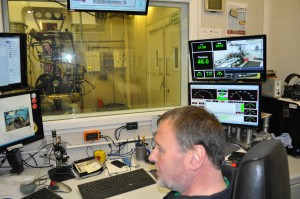
With running-in under way – I arranged to meet Steve at the dyno the following evening (Tue 4th Feb) to discuss the running-in results with him and Neil and to observe adjustments and further power runs to optimise engine set-up and performance.
On the drive out from Central London to the dyno in Westcott, Buckinghamshire my excitement turned to mild panic when my satnav decided to direct me in ever decreasing circles around the Southern perimeter of the industrial estate where BS Motorsports is located instead of taking me directly to entrance gate. (Neil later informed me this is a known issue as satnavs try to direct their hapless drivers to an entry point to the site that no longer exists!)
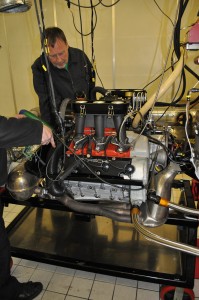
Fortunately Steve hadn’t arrived yet so I’d not missed anything and over a welcome coffee and cake, Neil was able to give me the low-down on initial engine fire-up, the running-in procedure and the power runs he’d already carried out.
In the comfort of the dyno control room Neil ran me through the output from previous runs and fired up the engine to show me how it’s done. Edited highlights were as follows:-
- Minor oil & fuel leaks spotted on initial fire-up were fixed by tightening various nuts and bolts on, amongst other things, the oil-fed cam tensioners and fuel lines to the injectors
- Once sorted the engine ran pretty well through the running-in sequence
- With the running-in cycle completed – Neil was able to run the engine up to 6500rpm and then to 7000rpm without any problem to take his many and varied readings from sensors attached to the engine. It really looked like the engine was hooked up to life support in a hospital intensive care unit!
- The engine gave consistent power and torque readings of around 180bhp and 140lb ft
- Most pleasing of all – the torque curve was very smooth with none of the lumps and bumps normally seen with MFI engines
- Fuelling was slightly imbalanced with one bank running rich and the other lean
- Engine idling was a problem which suggested that air was getting past the throttle body butterflies
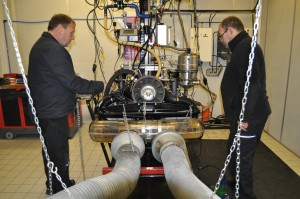
When Steve arrived, Neil briefed him with results, read-outs and a range of baffling graphs before the pair of them agreed on the adjustments to be made and the sequence in which to tackle them:-
- First on the list was the leaky butterflies – throttle linkages on both cylinder banks were disconnected and each butterfly was adjusted to the fully closed position. Throttle linkages were then adjusted to the new butterfly positions and reconnected to ensure consistent movement of the butterflies on each bank
- The engine was run up again and although the idling problem was fixed – it was hitting the rev limiter at around 165bhp
- The timing was adjusted and the engine was run up again
- This showed an improvement but the rev limiter was still kicking-in so further adjustments were made to timing and to the rev limiter itself within the distributor
- On the next engine run – the engine misfired but this was cleared by another small timing adjustment
- At around 9PM on the last engine run of the day – it ran smoothly through the revs and gave readings of 185bhp and 150lb ft of torque
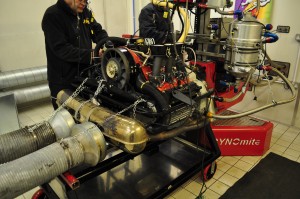
Over another cuppa, Neil and Steve had a chat about the results. Their conclusions were that although power was not massively above the 180bhp for a “standard” 2.2S there was a massive improvement in torque and most especially in the torque curve. Steve emphasised that this should provide great driveability – the most important factor for a road car.
They went on to explain that whilst another 8-10 bhp could possibly be eked out through valve and cam timing adjustments these would probably be detrimental to overall torque. Not an issue in race applications as revs are kept high but for a road car – torque is much more important.
The only remaining tweak was to check and if necessary adjust the weights and springs in the distributor. This was a job that Neil would tackle the following day before unplugging the engine from the dyno to make way for the next in his long queue of customer engines to be sorted.
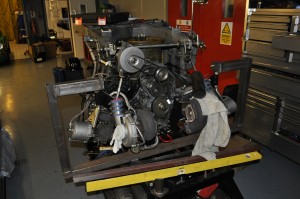
As an aside – Steve was particularly interested in the prospect of observing a 935 engine due to be on the dyno the following week. It was pretty clear that Neil was also relishing the prospect when he commented that “we might switch the lights off for that one!” ……. to watch those enormous twin turbos glowing in the dark! I’ll be keen to see the video of this.
I spent three fascinating hours trying to follow Neil and Steve’s meticulous technical analysis of results and read-outs, followed by their ideas and recommendations on how to optimise engine performance. It was a real privilege to watch their methodical approach in trying out their theories and witness the immediate effects of their adjustments. I came away extremely pleased with the experience and very satisfied with the results.
Although on paper dyno testing of a newly rebuilt engine looks pricey (especially after the expenditure of the rebuild) – it’s actually the most sensible and cost-effective approach.
As Steve pointed out – the total labour cost of sticking a newly rebuilt engine back into a car and following the “conventional” running-in process including multiple visits back to the garage to try out various ideas and adjustments very quickly exceeds the cost of the dyno approach. There’s also the further benefit that the 1st service of the engine can be carried out whilst it’s still plugged into the dyno. I’d strongly recommend the dyno approach and for sorting out any Porsche engines and look no further than Neil Bainbridge at BS Motorsport to do the sorting.
I hope to add some of the graphs and readouts from the dyno process as soon I get them from Neil and, hopefully, I’ll be able to include a video clip of one of the later engine power runs as the noise it made was just great .
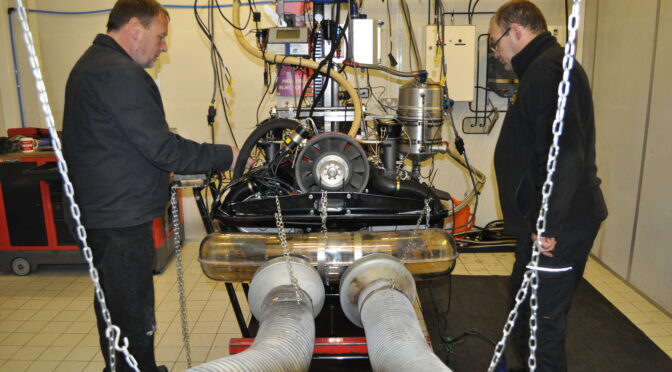
At long last it runs again and, yes Phil, we all want to hear it. Please post the video.
Cheers
Thanks Gordon. Steve’s collecting the engine today and I guess he’ll also pick up all of the dyno output and the video of power runs so I’ll add the edited highlights to the post as soon as I can.
Yes, please post the video of the dyno test, and the video once your fire it up in the 911E – its final resting place!! As always, great blog!
Thanks Matt. Looking forward to car and engine being reunited. It’ll be interesting to hear it outside the confines of a dyno booth. I suspect it’ll be triggering a few motion sensor alarms of cars parked on the streets of North London!!!
Hi Phil, this sounds like a software debugging exercise. I had recently rebuilt the engine in my Jeep and we are going through the conventional running in process. However, I do not think we are testing it fully as high revs etc. is not being done. Looks like you are going to end up with a fantastic car! Sudeesh
Hi Sudeesh, Yes the dyno de-bugging was really interesting to watch. Still some possible issues with the distributor but not a show-stopper. The engine and car will be reunited today so looking forward to getting my hands on it. Shame the weather forecast is so unremittingly grim – I could do with a good long drive the re-acquaint myself with the car. Cheers, Phil.